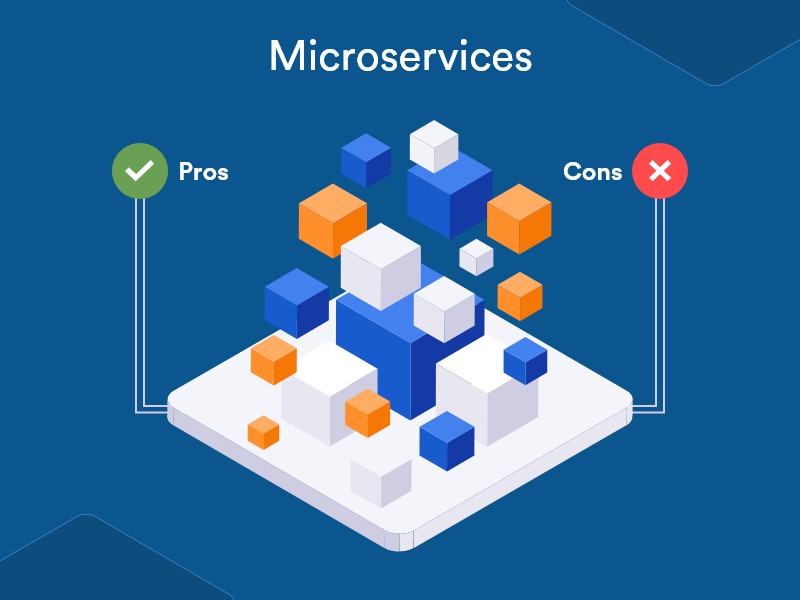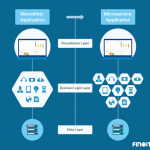Microservice Architecture: Unveiling the Advantages and Disadvantages

Enterprise software applications are commonly developed using two types of architectures, namely Monolithic and Microservices. While Monoliths have been around for a while, the advantages of microservices architecture make it increasingly popular.
Many companies are, therefore, interested in investing and knowing how to convert monolithic to microservices architecture. Hence, it’s a reasonable time to adopt a microservices architecture, with over 75% of organizations already integrating it into their operations.
However, it’s essential to understand that microservices are not a cure-all solution. As with any technological solution, they have their own set of risks and drawbacks. To better understand whether your business should transition to a new architectural model, we will examine the advantages and disadvantages of microservices.
We will also explore how it helps in modernizing applications and how to navigate the primary challenges associated with implementing a microservices architecture.
A Basic Definition of Microservices Architecture for Developers
Microservices architecture is an innovative approach to developing software systems. It involves breaking down an application into multiple smaller services, where each service runs its own process and communicates with lighter techniques like HyperText Transfer Protocol (HTTP), Extensible Messaging and Presence Protocol (XMPP)Advanced or Message Queuing Protocol (AMQP). It is easier to manage and maintain each service independently. A coder can use any programming language can be used to write them, using any combination of technologies. Additionally, microservices have their own data model and can manage their own database. The most commonly used programming languages for microservices are Java, Node.js, and Golang.
Microservices are ideal for various purposes, such as developing new features or scaling an entire application. They also enable the creation of modular application development. Containers are frequently utilized to support microservices, allowing you to bundle and execute your services self-contained. By leveraging containers, it becomes effortless to deploy your services to various environments.
What is the approach behind Microservices?
To start our discussion on the pros and cons of Microservices Architecture, let’s establish a basic understanding of microservices. They are an approach to breaking down large software projects into smaller, self-contained modules that interact through simple Application Programming Interfaces (APIs).
Over the past few years, enterprise agility and scalability in microservices have become increasingly popular. They represent a modular architectural style, subdividing large software development projects into smaller, self-sufficient, and loosely connected components.
This approach is popular among developers because it is dynamic and agile, especially when managing APIs and performing specific, well-defined tasks. In essence, microservices are an alternative architectural solution for building complex web-based applications. They have emerged as an improvement over Service Oriented Architecture (SOA), a methodology developed to address the limitations of traditional monolithic architectures.
In the following part of the blog post, we’ll explore the advantages and disadvantages that microservices offer.
What are the Benefits of Microservices Architecture?
Microservices architecture offers several advantages, making it a popular choice for designing and modernizing applications. Some of the key benefits include:
Scalability:
Microservices allow individual components or independent services to be scaled independently based on their specific resource requirements. This results in efficient resource utilization and cost savings.
Flexibility:
Developers can choose the most appropriate technology stack, programming language, and database for each microservice, enabling flexibility in technology selection and adaptation to specific needs.
Rapid Development:
Microservices enable teams to work on small, focused components, leading to faster development cycles and quicker time-to-market for new features and updates.
Improved Data Security
Microservices enable secure communication through APIs like HTTPS, resulting in 29% better data security. They also facilitate compliance with data protection regulations by establishing clear service boundaries and data flows.
Low Maintenance:
Smaller codebases are easier to understand, test, and maintain, reducing the complexity associated with monolithic applications.
Continuous Deployment:
Microservices facilitate continuous integration and continuous deployment (CI/CD) practices, making it easier to release updates and improvements. Therefore, a client using this technology will receive real-time updates consistently, leading to a heightened satisfaction level of 30% based on an analysis made by IBM.
Improved Collaboration:
Development teams can be organized around specific microservices, fostering collaboration, specialization, and autonomy.
Modularity:
Applications are divided into smaller, manageable components, simplifying development, testing, and troubleshooting.
Enhanced Resilience:
Microservices can be designed to automatically recover from failures, improving the overall resilience of the application.
Resource Efficiency:
Microservices can run in containerized environments or serverless architectures, optimizing resource utilization and reducing infrastructure costs.
Better User Experience:
Rapid updates and feature additions can lead to a more responsive and engaging user experience.
Better Data fault Isolation:
Microservices often have their own databases, enhancing data isolation, security, and compliance.
Granular Monitoring:
Individual microservices can be monitored independently, providing granular insights into the health and performance of the system.
Compatible with all Program Languages and Technology:
Developers can program microservices in any language they know, leveraging their skill sets effectively. Cloud-based microservices by cloud consulting service providers also provide accessibility from any internet-connected device.
Streamlines Deployment:
Microservices architecture allows independent deployment of applications without impacting other services. This enables developers to add new modules without redesigning the system’s complete structure, making it easy for businesses to add new features as needed efficiently.
Reusability Across Different Business lines:
Some microservice applications may be shareable across a business. The microservice application can be used for multiple areas with distinct login and payment options.
Quicker Production Release:
Developers can seamlessly integrate this ‘microsurgery’ into the architecture, avoiding conflicts or service disruptions. Multiple development teams can work independently, enabling rapid feature development and technology upgrades.”
Open to Experimentation:
Using a microservices architecture makes experimenting simpler. Each service is independent, allowing for easy roll-out of new features. Rolling back changes won’t affect the rest of the operation if necessary. Microservices also enable faster implementation of customer requests.
Better Security:
Breaking down the computer systems architecture into smaller components protects sensitive data from intrusions. Secure APIs ensure authorized access to data. It’s easier to comply with data security standards like HIPAA (The Health Insurance Portability and Accountability Act) and GDPR (The General Data Protection Regulation) if handling sensitive data.
Flexible to Outsourcing:
Intellectual property protection can be a concern when outsourcing business functions to third-party partners. A microservices architecture can help by segmenting partner-specific areas without affecting core services.
Team-Friendly:
Following the two-pizza rule when assigning team sizes for microservices is critical to optimize work efficiency. This rule, established by Amazon, recommends keeping teams small enough to be fed by two pizzas. Doing so can help businesses achieve their goals faster, make teams easier to manage, increase focus, and improve product quality.
What are the Disadvantages of Microservice Architecture
Understanding the disadvantages of microservice architecture is essential for several reasons. First and foremost, knowing these drawbacks can help organizations make informed decisions when considering whether or not to adopt this architectural style. By understanding the challenges, such as increased complexity and a higher learning curve, businesses can weigh the potential benefits or cons against the costs and determine if microservices fit their needs. Below, we have listed the probable disadvantages of microservices:
Complexity:
Managing many microservices can be complex. The more services you have, the harder it becomes to coordinate and monitor them effectively.
Distributed Systems Complexity:
Microservices are inherently distributed systems that introduce network latency, data consistency, and fault tolerance challenges. These issues can be complex to address.
Increased Development Overhead:
Developing and maintaining a microservices-based application often requires more effort than building a monolithic application. Each service needs its codebase, testing, deployment pipeline, and documentation.
Deployment and Scaling Complexity:
Deploying and scaling numerous microservices can be challenging. Tools like container orchestration (e.g., Kubernetes) can help, but they introduce their complexity.
Operational Overhead:
Monitoring, logging, and debugging microservices can be more challenging than in a monolithic system. Managing the operational aspects of each service can be resource-intensive.
Data Management:
Handling data in a microservices architecture can be complex. Data may be distributed across multiple services, making data consistency and integrity more challenging to maintain.
Testing Complexity:
Testing microservices often involves more complex scenarios due to inter-service communication. Comprehensive end-to-end testing can be time-consuming and complex.
Security Challenges:
Securing microservices can be more complex than securing a monolithic application. You need to manage access control and authentication across multiple services.
Increased Costs:
The infrastructure and tooling required for microservices can be more expensive than a more straightforward monolithic setup. Smaller teams may also require more resources.
Integration Overhead:
Even though microservices should ideally be loosely coupled, managing their integration points can become challenging. Frequent changes to services may require constant updates to the integration code.
Potential for Service Sprawl:
Without proper governance, organizations may have excessive microservices, leading to a phenomenon known as “service sprawl.”
Transitioning to microservices may require a shift in skills and culture. Teams may need to learn new technologies and approaches, which can take time.
It’s important to note that while microservices have their challenges, they can be highly beneficial for certain types of applications and organizations. Choosing microservices should be based on carefully evaluating your specific needs and constraints.
How does Microservice Architecture help in modernizing Applications?
When you migrate your present architecture to a service-oriented architecture (SOA), i.e., microservices, your initial goal will be to address your evolving business needs. Over time, your applications grow significantly in size as they integrate with various components to support all areas of your business. This growth also required you to modernize your hardware infrastructure by incorporating virtual machines.
However, despite the initial promises of SOA, you may have encountered challenges with application scalability. It might not have met critical workload requirements or fulfilled basic needs like on-demand scaling, shorter testing cycles, cost reduction, and faster time to market.
You may have considered adopting a microservices architecture or hiring a legacy software modernization company to overcome these challenges. In a microservices approach, applications are designed as loosely interconnected services that can be developed, deployed, and scaled independently. As the name suggests, these microservices are typically small in scope, each focusing on a single functionality and possibly sharing a common database. They are deployed as containers managed by a container orchestrator, allowing you to scale them as needed. However, despite the initial assurances provided by SOA, you may have faced obstacles to the application’s ability to handle increasing workloads. It might not have fulfilled critical requirements concerning workload, nor have it addressed fundamental necessities such as flexible scaling, shorter testing cycles, reduced costs, and a quicker time-to-market.
Potentially, you have contemplated the adoption of a microservices architecture or engaging a company specializing in the modernization of legacy software to overcome these challenges. In a microservices approach, applications are conceived as interrelated services that are loosely connected and can be developed, deployed, and scaled independently. As implied by its title, these microservices are usually encompass narrow domains, focusing on a single functionality while potentially sharing a shared database. Their deployment is carried out through containers, managed by a container orchestrator, enabling you to adjust their scaling according to your specific requirements easily.
With this approach, you can quickly change existing functionalities or add new features, often with shorter testing cycles. It doesn’t require a large team to work on these changes or introduce new functionalities. This smaller team size can lead to on-time, defect-free deliveries and reduce management overhead.
This transition may also entail a shift in your underlying infrastructure and methodology to better align with the demands of the modern era.
Conclusion
One of the key advantages of microservice architecture is its flexibility. Since each service operates independently, changes and updates can be made without affecting the entire system. This allows for continuous development and deployment, reducing the time and effort required for implementing new features or fixing bugs.
Additionally, microservices can be developed in different programming languages and use different technologies, enabling development teams to choose the most suitable tools for each service.
However, along with its numerous advantages, microservice architecture also has its disadvantages. One of the challenges is the increased complexity of managing a distributed system. With multiple services working together, monitoring and debugging can become more complex. Additionally, communication between services is crucial, and network latency or failures can affect the overall system’s performance.
It also requires additional infrastructure, operational overhead, and an efficient software development service provider to manage and deploy multiple services. To learn more about microservices and their compatibility with your business, connect with the Cloud computing services team or email info@finoit.com.

